| Listing 1 - 10 of 17 | << page >> |
Sort by
|
Book
ISBN: 3039217313 3039217305 Year: 2019 Publisher: MDPI - Multidisciplinary Digital Publishing Institute
Abstract | Keywords | Export | Availability | Bookmark
 Loading...
Loading...Choose an application
- Reference Manager
- EndNote
- RefWorks (Direct export to RefWorks)
Although scientific computing is very often associated with numeric computations, the use of computer algebra methods in scientific computing has obtained considerable attention in the last two decades. Computer algebra methods are especially suitable for parametric analysis of the key properties of systems arising in scientific computing. The expression-based computational answers generally provided by these methods are very appealing as they directly relate properties to parameters and speed up testing and tuning of mathematical models through all their possible behaviors. This book contains 8 original research articles dealing with a broad range of topics, ranging from algorithms, data structures, and implementation techniques for high-performance sparse multivariate polynomial arithmetic over the integers and rational numbers over methods for certifying the isolated zeros of polynomial systems to computer algebra problems in quantum computing.
superposition --- SU(2) --- pseudo-remainder --- interval methods --- sparse polynomials --- element order --- Henneberg-type minimal surface --- timelike axis --- combinatorial decompositions --- sparse data structures --- mutually unbiased bases --- invariant surfaces --- projective special unitary group --- Minkowski 4-space --- free resolutions --- Dini-type helicoidal hypersurface --- linearity --- integrability --- Galois rings --- minimum point --- entanglement --- degree --- pseudo-division --- computational algebra --- polynomial arithmetic --- projective special linear group --- normal form --- Galois fields --- Gauss map --- implicit equation --- number of elements of the same order --- Weierstrass representation --- Lotka–Volterra system --- isolated zeros --- polynomial modules --- over-determined polynomial system --- simple Kn-group --- sum of squares --- four-dimensional space
Book
ISBN: 1400881803 Year: 2016 Publisher: Princeton, NJ : Princeton University Press,
Abstract | Keywords | Export | Availability | Bookmark
 Loading...
Loading...Choose an application
- Reference Manager
- EndNote
- RefWorks (Direct export to RefWorks)
One of the most cited books in mathematics, John Milnor's exposition of Morse theory has been the most important book on the subject for more than forty years. Morse theory was developed in the 1920s by mathematician Marston Morse. (Morse was on the faculty of the Institute for Advanced Study, and Princeton published his Topological Methods in the Theory of Functions of a Complex Variable in the Annals of Mathematics Studies series in 1947.) One classical application of Morse theory includes the attempt to understand, with only limited information, the large-scale structure of an object. This kind of problem occurs in mathematical physics, dynamic systems, and mechanical engineering. Morse theory has received much attention in the last two decades as a result of a famous paper in which theoretical physicist Edward Witten relates Morse theory to quantum field theory. Milnor was awarded the Fields Medal (the mathematical equivalent of a Nobel Prize) in 1962 for his work in differential topology. He has since received the National Medal of Science (1967) and the Steele Prize from the American Mathematical Society twice (1982 and 2004) in recognition of his explanations of mathematical concepts across a wide range of scienti.c disciplines. The citation reads, "The phrase sublime elegance is rarely associated with mathematical exposition, but it applies to all of Milnor's writings. Reading his books, one is struck with the ease with which the subject is unfolding and it only becomes apparent after re.ection that this ease is the mark of a master.? Milnor has published five books with Princeton University Press.
Homotopy theory. --- Geometry, Differential. --- Affine connection. --- Banach algebra. --- Betti number. --- Bott periodicity theorem. --- Bounded set. --- Calculus of variations. --- Cauchy sequence. --- Characteristic class. --- Clifford algebra. --- Compact space. --- Complex number. --- Conjugate points. --- Coordinate system. --- Corollary. --- Covariant derivative. --- Covering space. --- Critical point (mathematics). --- Curvature. --- Cyclic group. --- Derivative. --- Diagram (category theory). --- Diffeomorphism. --- Differentiable function. --- Differentiable manifold. --- Differential geometry. --- Differential structure. --- Differential topology. --- Dimension (vector space). --- Dirichlet problem. --- Elementary proof. --- Euclidean space. --- Euler characteristic. --- Exact sequence. --- Exponentiation. --- First variation. --- Function (mathematics). --- Fundamental lemma (Langlands program). --- Fundamental theorem. --- General position. --- Geometry. --- Great circle. --- Hessian matrix. --- Hilbert space. --- Homomorphism. --- Homotopy group. --- Homotopy. --- Implicit function theorem. --- Inclusion map. --- Infimum and supremum. --- Jacobi field. --- Lie algebra. --- Lie group. --- Line segment. --- Linear equation. --- Linear map. --- Loop space. --- Manifold. --- Mathematical induction. --- Metric connection. --- Metric space. --- Morse theory. --- N-sphere. --- Order of approximation. --- Orthogonal group. --- Orthogonal transformation. --- Paraboloid. --- Path space. --- Piecewise. --- Projective plane. --- Real number. --- Retract. --- Ricci curvature. --- Riemannian geometry. --- Riemannian manifold. --- Sard's theorem. --- Second fundamental form. --- Sectional curvature. --- Sequence. --- Simply connected space. --- Skew-Hermitian matrix. --- Smoothness. --- Special unitary group. --- Square-integrable function. --- Subgroup. --- Submanifold. --- Subset. --- Symmetric space. --- Tangent space. --- Tangent vector. --- Theorem. --- Topological group. --- Topological space. --- Topology. --- Torus. --- Unit sphere. --- Unit vector. --- Unitary group. --- Vector bundle. --- Vector field. --- Vector space.
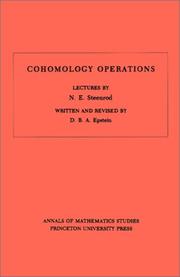
ISBN: 0691079242 1400881676 Year: 2016 Publisher: Princeton, NJ : Princeton University Press,
Abstract | Keywords | Export | Availability | Bookmark
 Loading...
Loading...Choose an application
- Reference Manager
- EndNote
- RefWorks (Direct export to RefWorks)
Written and revised by D. B. A. Epstein.
Category theory. Homological algebra --- 515.14 --- Algebraic topology --- Homology theory. --- 515.14 Algebraic topology --- Cohomology theory --- Contrahomology theory --- Algebra homomorphism. --- Algebra over a field. --- Algebraic structure. --- Approximation. --- Axiom. --- Basis (linear algebra). --- CW complex. --- Cartesian product. --- Classical group. --- Coefficient. --- Cohomology operation. --- Cohomology ring. --- Cohomology. --- Commutative property. --- Complex number. --- Computation. --- Continuous function. --- Cup product. --- Cyclic group. --- Diagram (category theory). --- Dimension. --- Direct limit. --- Embedding. --- Existence theorem. --- Fibration. --- Homomorphism. --- Hopf algebra. --- Hopf invariant. --- Ideal (ring theory). --- Integer. --- Inverse limit. --- Manifold. --- Mathematics. --- Monomial. --- N-skeleton. --- Natural transformation. --- Permutation. --- Quaternion. --- Ring (mathematics). --- Scalar (physics). --- Special unitary group. --- Steenrod algebra. --- Stiefel manifold. --- Subgroup. --- Subset. --- Summation. --- Symmetric group. --- Symplectic group. --- Theorem. --- Uniqueness theorem. --- Upper and lower bounds. --- Vector field. --- Vector space. --- W0.
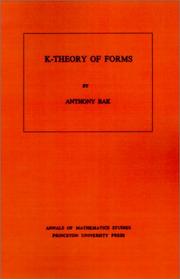
ISBN: 069108274X 0691082758 1400881412 9780691082752 9780691082745 Year: 2016 Volume: 98 Publisher: Princeton, NJ : Princeton University Press,
Abstract | Keywords | Export | Availability | Bookmark
 Loading...
Loading...Choose an application
- Reference Manager
- EndNote
- RefWorks (Direct export to RefWorks)
The description for this book, K-Theory of Forms. (AM-98), Volume 98, will be forthcoming.
Category theory. Homological algebra --- 515.14 --- Algebraic topology --- 515.14 Algebraic topology --- Forms (Mathematics) --- K-theory --- Modules (Algebra) --- Finite number systems --- Modular systems (Algebra) --- Algebra --- Finite groups --- Rings (Algebra) --- Homology theory --- Quantics --- Mathematics --- K-theory. --- Abelian group. --- Addition. --- Algebraic K-theory. --- Algebraic topology. --- Approximation. --- Arithmetic. --- Canonical map. --- Coefficient. --- Cokernel. --- Computation. --- Coprime integers. --- Coset. --- Direct limit. --- Direct product. --- Division ring. --- Elementary matrix. --- Exact sequence. --- Finite group. --- Finite ring. --- Free module. --- Functor. --- General linear group. --- Global field. --- Group homomorphism. --- Group ring. --- Homology (mathematics). --- Integer. --- Invertible matrix. --- Isomorphism class. --- Linear map. --- Local field. --- Matrix group. --- Maxima and minima. --- Mayer–Vietoris sequence. --- Module (mathematics). --- Monoid. --- Morphism. --- Natural transformation. --- Normal subgroup. --- P-group. --- Parameter. --- Power of two. --- Product category. --- Projective module. --- Quadratic form. --- Requirement. --- Ring of integers. --- Semisimple algebra. --- Sesquilinear form. --- Special case. --- Steinberg group (K-theory). --- Steinberg group. --- Subcategory. --- Subgroup. --- Subspace topology. --- Surjective function. --- Theorem. --- Theory. --- Topological group. --- Topological ring. --- Topology. --- Torsion subgroup. --- Triviality (mathematics). --- Unification (computer science). --- Unitary group. --- Witt group. --- K-théorie
Book
ISBN: 1282458000 1282936328 9786612936326 9786612458002 1400835399 9781400835393 9780691142920 0691142920 0691142939 9780691142937 Year: 2010 Publisher: Princeton Princeton University Press
Abstract | Keywords | Export | Availability | Bookmark
 Loading...
Loading...Choose an application
- Reference Manager
- EndNote
- RefWorks (Direct export to RefWorks)
This book studies the intersection cohomology of the Shimura varieties associated to unitary groups of any rank over Q. In general, these varieties are not compact. The intersection cohomology of the Shimura variety associated to a reductive group G carries commuting actions of the absolute Galois group of the reflex field and of the group G(Af) of finite adelic points of G. The second action can be studied on the set of complex points of the Shimura variety. In this book, Sophie Morel identifies the Galois action--at good places--on the G(Af)-isotypical components of the cohomology. Morel uses the method developed by Langlands, Ihara, and Kottwitz, which is to compare the Grothendieck-Lefschetz fixed point formula and the Arthur-Selberg trace formula. The first problem, that of applying the fixed point formula to the intersection cohomology, is geometric in nature and is the object of the first chapter, which builds on Morel's previous work. She then turns to the group-theoretical problem of comparing these results with the trace formula, when G is a unitary group over Q. Applications are then given. In particular, the Galois representation on a G(Af)-isotypical component of the cohomology is identified at almost all places, modulo a non-explicit multiplicity. Morel also gives some results on base change from unitary groups to general linear groups.
Shimura varieties. --- Homology theory. --- Cohomology theory --- Contrahomology theory --- Algebraic topology --- Varieties, Shimura --- Arithmetical algebraic geometry --- Accuracy and precision. --- Adjoint. --- Algebraic closure. --- Archimedean property. --- Automorphism. --- Base change map. --- Base change. --- Calculation. --- Clay Mathematics Institute. --- Coefficient. --- Compact element. --- Compact space. --- Comparison theorem. --- Conjecture. --- Connected space. --- Connectedness. --- Constant term. --- Corollary. --- Duality (mathematics). --- Existential quantification. --- Exterior algebra. --- Finite field. --- Finite set. --- Fundamental lemma (Langlands program). --- Galois group. --- General linear group. --- Haar measure. --- Hecke algebra. --- Homomorphism. --- L-function. --- Logarithm. --- Mathematical induction. --- Mathematician. --- Maximal compact subgroup. --- Maximal ideal. --- Morphism. --- Neighbourhood (mathematics). --- Open set. --- Parabolic induction. --- Permutation. --- Prime number. --- Ramanujan–Petersson conjecture. --- Reductive group. --- Ring (mathematics). --- Scientific notation. --- Shimura variety. --- Simply connected space. --- Special case. --- Sub"ient. --- Subalgebra. --- Subgroup. --- Symplectic group. --- Theorem. --- Trace formula. --- Unitary group. --- Weyl group.
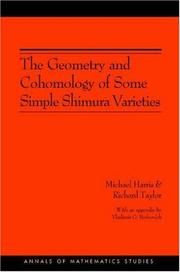
ISBN: 1400837200 9781400837205 0691090920 9780691090924 Year: 2001 Publisher: Princeton Princeton University Press
Abstract | Keywords | Export | Availability | Bookmark
 Loading...
Loading...Choose an application
- Reference Manager
- EndNote
- RefWorks (Direct export to RefWorks)
This book aims first to prove the local Langlands conjecture for GLn over a p-adic field and, second, to identify the action of the decomposition group at a prime of bad reduction on the l-adic cohomology of the "simple" Shimura varieties. These two problems go hand in hand. The results represent a major advance in algebraic number theory, finally proving the conjecture first proposed in Langlands's 1969 Washington lecture as a non-abelian generalization of local class field theory. The local Langlands conjecture for GLn(K), where K is a p-adic field, asserts the existence of a correspondence, with certain formal properties, relating n-dimensional representations of the Galois group of K with the representation theory of the locally compact group GLn(K). This book constructs a candidate for such a local Langlands correspondence on the vanishing cycles attached to the bad reduction over the integer ring of K of a certain family of Shimura varieties. And it proves that this is roughly compatible with the global Galois correspondence realized on the cohomology of the same Shimura varieties. The local Langlands conjecture is obtained as a corollary. Certain techniques developed in this book should extend to more general Shimura varieties, providing new instances of the local Langlands conjecture. Moreover, the geometry of the special fibers is strictly analogous to that of Shimura curves and can be expected to have applications to a variety of questions in number theory.
Mathematics --- Shimura varieties. --- MATHEMATICS / Number Theory. --- Varieties, Shimura --- Arithmetical algebraic geometry --- Math --- Science --- Abelian variety. --- Absolute value. --- Algebraic group. --- Algebraically closed field. --- Artinian. --- Automorphic form. --- Base change. --- Bijection. --- Canonical map. --- Codimension. --- Coefficient. --- Cohomology. --- Compactification (mathematics). --- Conjecture. --- Corollary. --- Dimension (vector space). --- Dimension. --- Direct limit. --- Division algebra. --- Eigenvalues and eigenvectors. --- Elliptic curve. --- Embedding. --- Equivalence class. --- Equivalence of categories. --- Existence theorem. --- Field of fractions. --- Finite field. --- Function field. --- Functor. --- Galois cohomology. --- Galois group. --- Generic point. --- Geometry. --- Hasse invariant. --- Infinitesimal character. --- Integer. --- Inverse system. --- Isomorphism class. --- Lie algebra. --- Local class field theory. --- Maximal torus. --- Modular curve. --- Moduli space. --- Monic polynomial. --- P-adic number. --- Prime number. --- Profinite group. --- Residue field. --- Ring of integers. --- Separable extension. --- Sheaf (mathematics). --- Shimura variety. --- Simple group. --- Special case. --- Spectral sequence. --- Square root. --- Subset. --- Tate module. --- Theorem. --- Transcendence degree. --- Unitary group. --- Valuative criterion. --- Variable (mathematics). --- Vector space. --- Weil group. --- Weil pairing. --- Zariski topology.
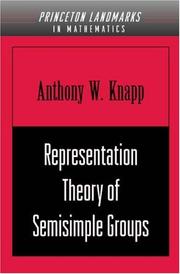
ISBN: 0691090890 9780691090894 0691084017 1400883970 9780691084015 Year: 2016 Volume: 36 Publisher: Princeton, NJ : Princeton University Press,
Abstract | Keywords | Export | Availability | Bookmark
 Loading...
Loading...Choose an application
- Reference Manager
- EndNote
- RefWorks (Direct export to RefWorks)
In this classic work, Anthony W. Knapp offers a survey of representation theory of semisimple Lie groups in a way that reflects the spirit of the subject and corresponds to the natural learning process. This book is a model of exposition and an invaluable resource for both graduate students and researchers. Although theorems are always stated precisely, many illustrative examples or classes of examples are given. To support this unique approach, the author includes for the reader a useful 300-item bibliography and an extensive section of notes.
Semisimple Lie groups. --- Representations of groups. --- Groupes de Lie semi-simples --- Représentations de groupes --- Semisimple Lie groups --- Representations of groups --- Semi-simple Lie groups --- Lie groups --- Group representation (Mathematics) --- Groups, Representation theory of --- Group theory --- Représentations de groupes --- 512.547 --- 512.547 Linear representations of abstract groups. Group characters --- Linear representations of abstract groups. Group characters --- Abelian group. --- Admissible representation. --- Algebra homomorphism. --- Analytic function. --- Analytic proof. --- Associative algebra. --- Asymptotic expansion. --- Automorphic form. --- Automorphism. --- Bounded operator. --- Bounded set (topological vector space). --- Cartan subalgebra. --- Cartan subgroup. --- Category theory. --- Characterization (mathematics). --- Classification theorem. --- Cohomology. --- Complex conjugate representation. --- Complexification (Lie group). --- Complexification. --- Conjugate transpose. --- Continuous function (set theory). --- Degenerate bilinear form. --- Diagram (category theory). --- Dimension (vector space). --- Dirac operator. --- Discrete series representation. --- Distribution (mathematics). --- Eigenfunction. --- Eigenvalues and eigenvectors. --- Existence theorem. --- Explicit formulae (L-function). --- Fourier inversion theorem. --- General linear group. --- Group homomorphism. --- Haar measure. --- Heine–Borel theorem. --- Hermitian matrix. --- Hilbert space. --- Holomorphic function. --- Hyperbolic function. --- Identity (mathematics). --- Induced representation. --- Infinitesimal character. --- Integration by parts. --- Invariant subspace. --- Invertible matrix. --- Irreducible representation. --- Jacobian matrix and determinant. --- K-finite. --- Levi decomposition. --- Lie algebra. --- Locally integrable function. --- Mathematical induction. --- Matrix coefficient. --- Matrix group. --- Maximal compact subgroup. --- Meromorphic function. --- Metric space. --- Nilpotent Lie algebra. --- Norm (mathematics). --- Parity (mathematics). --- Plancherel theorem. --- Projection (linear algebra). --- Quantifier (logic). --- Reductive group. --- Representation of a Lie group. --- Representation theory. --- Schwartz space. --- Semisimple Lie algebra. --- Set (mathematics). --- Sign (mathematics). --- Solvable Lie algebra. --- Special case. --- Special linear group. --- Special unitary group. --- Subgroup. --- Summation. --- Support (mathematics). --- Symmetric algebra. --- Symmetrization. --- Symplectic group. --- Tensor algebra. --- Tensor product. --- Theorem. --- Topological group. --- Topological space. --- Topological vector space. --- Unitary group. --- Unitary matrix. --- Unitary representation. --- Universal enveloping algebra. --- Variable (mathematics). --- Vector bundle. --- Weight (representation theory). --- Weyl character formula. --- Weyl group. --- Weyl's theorem. --- ZPP (complexity). --- Zorn's lemma.
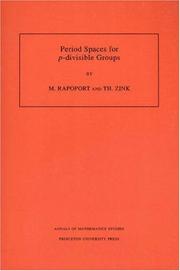
ISBN: 0691027811 1400882605 9780691027814 Year: 1996 Volume: 141 Publisher: Princeton (N.J.): Princeton university press
Abstract | Keywords | Export | Availability | Bookmark
 Loading...
Loading...Choose an application
- Reference Manager
- EndNote
- RefWorks (Direct export to RefWorks)
In this monograph p-adic period domains are associated to arbitrary reductive groups. Using the concept of rigid-analytic period maps the relation of p-adic period domains to moduli space of p-divisible groups is investigated. In addition, non-archimedean uniformization theorems for general Shimura varieties are established. The exposition includes background material on Grothendieck's "mysterious functor" (Fontaine theory), on moduli problems of p-divisible groups, on rigid analytic spaces, and on the theory of Shimura varieties, as well as an exposition of some aspects of Drinfelds' original construction. In addition, the material is illustrated throughout the book with numerous examples.
p-adic groups --- p-divisible groups --- Moduli theory --- 512.7 --- Theory of moduli --- Analytic spaces --- Functions of several complex variables --- Geometry, Algebraic --- Groups, p-divisible --- Group schemes (Mathematics) --- Groups, p-adic --- Group theory --- Algebraic geometry. Commutative rings and algebras --- 512.7 Algebraic geometry. Commutative rings and algebras --- p-divisible groups. --- Moduli theory. --- p-adic groups. --- Abelian variety. --- Addition. --- Alexander Grothendieck. --- Algebraic closure. --- Algebraic number field. --- Algebraic space. --- Algebraically closed field. --- Artinian ring. --- Automorphism. --- Base change. --- Basis (linear algebra). --- Big O notation. --- Bilinear form. --- Canonical map. --- Cohomology. --- Cokernel. --- Commutative algebra. --- Commutative ring. --- Complex multiplication. --- Conjecture. --- Covering space. --- Degenerate bilinear form. --- Diagram (category theory). --- Dimension (vector space). --- Dimension. --- Duality (mathematics). --- Elementary function. --- Epimorphism. --- Equation. --- Existential quantification. --- Fiber bundle. --- Field of fractions. --- Finite field. --- Formal scheme. --- Functor. --- Galois group. --- General linear group. --- Geometric invariant theory. --- Hensel's lemma. --- Homomorphism. --- Initial and terminal objects. --- Inner automorphism. --- Integral domain. --- Irreducible component. --- Isogeny. --- Isomorphism class. --- Linear algebra. --- Linear algebraic group. --- Local ring. --- Local system. --- Mathematical induction. --- Maximal ideal. --- Maximal torus. --- Module (mathematics). --- Moduli space. --- Monomorphism. --- Morita equivalence. --- Morphism. --- Multiplicative group. --- Noetherian ring. --- Open set. --- Orthogonal basis. --- Orthogonal complement. --- Orthonormal basis. --- P-adic number. --- Parity (mathematics). --- Period mapping. --- Prime element. --- Prime number. --- Projective line. --- Projective space. --- Quaternion algebra. --- Reductive group. --- Residue field. --- Rigid analytic space. --- Semisimple algebra. --- Sheaf (mathematics). --- Shimura variety. --- Special case. --- Subalgebra. --- Subgroup. --- Subset. --- Summation. --- Supersingular elliptic curve. --- Support (mathematics). --- Surjective function. --- Symmetric bilinear form. --- Symmetric space. --- Tate module. --- Tensor algebra. --- Tensor product. --- Theorem. --- Topological ring. --- Topology. --- Torsor (algebraic geometry). --- Uniformization theorem. --- Uniformization. --- Unitary group. --- Weil group. --- Zariski topology.
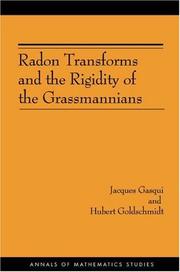
ISBN: 1282158988 9786612158988 1400826179 069111899X 0691118981 9781400826179 9780691118987 9780691118994 Year: 2004 Publisher: Princeton, N.J. Woodstock Princeton University Press
Abstract | Keywords | Export | Availability | Bookmark
 Loading...
Loading...Choose an application
- Reference Manager
- EndNote
- RefWorks (Direct export to RefWorks)
This book provides the first unified examination of the relationship between Radon transforms on symmetric spaces of compact type and the infinitesimal versions of two fundamental rigidity problems in Riemannian geometry. Its primary focus is the spectral rigidity problem: Can the metric of a given Riemannian symmetric space of compact type be characterized by means of the spectrum of its Laplacian? It also addresses a question rooted in the Blaschke problem: Is a Riemannian metric on a projective space whose geodesics are all closed and of the same length isometric to the canonical metric? The authors comprehensively treat the results concerning Radon transforms and the infinitesimal versions of these two problems. Their main result implies that most Grassmannians are spectrally rigid to the first order. This is particularly important, for there are still few isospectrality results for positively curved spaces and these are the first such results for symmetric spaces of compact type of rank ›1. The authors exploit the theory of overdetermined partial differential equations and harmonic analysis on symmetric spaces to provide criteria for infinitesimal rigidity that apply to a large class of spaces. A substantial amount of basic material about Riemannian geometry, symmetric spaces, and Radon transforms is included in a clear and elegant presentation that will be useful to researchers and advanced students in differential geometry.
Radon transforms. --- Grassmann manifolds. --- Grassmannians --- Transforms, Radon --- Differential topology --- Manifolds (Mathematics) --- Integral geometry --- Integral transforms --- Adjoint. --- Automorphism. --- Cartan decomposition. --- Cartan subalgebra. --- Casimir element. --- Closed geodesic. --- Cohomology. --- Commutative property. --- Complex manifold. --- Complex number. --- Complex projective plane. --- Complex projective space. --- Complex vector bundle. --- Complexification. --- Computation. --- Constant curvature. --- Coset. --- Covering space. --- Curvature. --- Determinant. --- Diagram (category theory). --- Diffeomorphism. --- Differential form. --- Differential geometry. --- Differential operator. --- Dimension (vector space). --- Dot product. --- Eigenvalues and eigenvectors. --- Einstein manifold. --- Elliptic operator. --- Endomorphism. --- Equivalence class. --- Even and odd functions. --- Exactness. --- Existential quantification. --- G-module. --- Geometry. --- Grassmannian. --- Harmonic analysis. --- Hermitian symmetric space. --- Hodge dual. --- Homogeneous space. --- Identity element. --- Implicit function. --- Injective function. --- Integer. --- Integral. --- Isometry. --- Killing form. --- Killing vector field. --- Lemma (mathematics). --- Lie algebra. --- Lie derivative. --- Line bundle. --- Mathematical induction. --- Morphism. --- Open set. --- Orthogonal complement. --- Orthonormal basis. --- Orthonormality. --- Parity (mathematics). --- Partial differential equation. --- Projection (linear algebra). --- Projective space. --- Quadric. --- Quaternionic projective space. --- Quotient space (topology). --- Radon transform. --- Real number. --- Real projective plane. --- Real projective space. --- Real structure. --- Remainder. --- Restriction (mathematics). --- Riemann curvature tensor. --- Riemann sphere. --- Riemannian manifold. --- Rigidity (mathematics). --- Scalar curvature. --- Second fundamental form. --- Simple Lie group. --- Standard basis. --- Stokes' theorem. --- Subgroup. --- Submanifold. --- Symmetric space. --- Tangent bundle. --- Tangent space. --- Tangent vector. --- Tensor. --- Theorem. --- Topological group. --- Torus. --- Unit vector. --- Unitary group. --- Vector bundle. --- Vector field. --- Vector space. --- X-ray transform. --- Zero of a function.
Book
ISBN: 0691197938 Year: 2019 Publisher: Princeton, NJ : Princeton University Press,
Abstract | Keywords | Export | Availability | Bookmark
 Loading...
Loading...Choose an application
- Reference Manager
- EndNote
- RefWorks (Direct export to RefWorks)
This book studies the interplay between the geometry and topology of locally symmetric spaces, and the arithmetic aspects of the special values of L-functions.The authors study the cohomology of locally symmetric spaces for GL(N) where the cohomology groups are with coefficients in a local system attached to a finite-dimensional algebraic representation of GL(N). The image of the global cohomology in the cohomology of the Borel-Serre boundary is called Eisenstein cohomology, since at a transcendental level the cohomology classes may be described in terms of Eisenstein series and induced representations. However, because the groups are sheaf-theoretically defined, one can control their rationality and even integrality properties. A celebrated theorem by Langlands describes the constant term of an Eisenstein series in terms of automorphic L-functions. A cohomological interpretation of this theorem in terms of maps in Eisenstein cohomology allows the authors to study the rationality properties of the special values of Rankin-Selberg L-functions for GL(n) x GL(m), where n + m = N. The authors carry through the entire program with an eye toward generalizations.This book should be of interest to advanced graduate students and researchers interested in number theory, automorphic forms, representation theory, and the cohomology of arithmetic groups.
Shimura varieties. --- Cohomology operations. --- Number theory. --- Arithmetic groups. --- L-functions. --- Functions, L --- -Number theory --- Group theory --- Number study --- Numbers, Theory of --- Algebra --- Operations (Algebraic topology) --- Algebraic topology --- Varieties, Shimura --- Arithmetical algebraic geometry --- Addition. --- Adele ring. --- Algebraic group. --- Algebraic number theory. --- Arithmetic group. --- Automorphic form. --- Base change. --- Basis (linear algebra). --- Bearing (navigation). --- Borel subgroup. --- Calculation. --- Category of groups. --- Coefficient. --- Cohomology. --- Combination. --- Commutative ring. --- Compact group. --- Computation. --- Conjecture. --- Constant term. --- Corollary. --- Covering space. --- Critical value. --- Diagram (category theory). --- Dimension. --- Dirichlet character. --- Discrete series representation. --- Discrete spectrum. --- Eigenvalues and eigenvectors. --- Eisenstein series. --- Elaboration. --- Embedding. --- Euler product. --- Field extension. --- Field of fractions. --- Free module. --- Freydoon Shahidi. --- Function field. --- Functor. --- Galois group. --- Ground field. --- Group (mathematics). --- Group scheme. --- Harish-Chandra. --- Hecke L-function. --- Hecke character. --- Hecke operator. --- Hereditary property. --- Induced representation. --- Irreducible representation. --- K0. --- L-function. --- Langlands dual group. --- Level structure. --- Lie algebra cohomology. --- Lie algebra. --- Lie group. --- Linear combination. --- Linear map. --- Local system. --- Maximal torus. --- Modular form. --- Modular symbol. --- Module (mathematics). --- Monograph. --- N0. --- National Science Foundation. --- Natural number. --- Natural transformation. --- Nilradical. --- Permutation. --- Prime number. --- Quantity. --- Rational number. --- Reductive group. --- Requirement. --- Ring of integers. --- Root of unity. --- SL2(R). --- Scalar (physics). --- Sheaf (mathematics). --- Special case. --- Spectral sequence. --- Standard L-function. --- Subgroup. --- Subset. --- Summation. --- Tensor product. --- Theorem. --- Theory. --- Triangular matrix. --- Triviality (mathematics). --- Two-dimensional space. --- Unitary group. --- Vector space. --- W0. --- Weyl group.
| Listing 1 - 10 of 17 | << page >> |
Sort by
|

 Search
Search Feedback
Feedback About
About Help
Help News
News